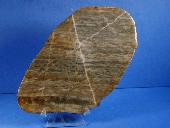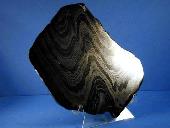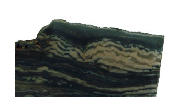|
 See More Images See More Images

Hadrophycus immanus
© 2004 The Virtual Fossil Museum

Banded Iron
© 2004 The Virtual Fossil Museum

(Stromatolite) Ozarkcollenia laminata
© 2005 Bruce Stinchcomb
|
What are Bacteria? Bacteria are unicellular organisms that have cell walls, organelles, and DNA, as do eukaryotes. However, unlike eukaryotes, their organelles and DNA are not contained within separate membranes inside the cells. Bacterial fossils hold the record for the oldest and smallest fossils ever found. Cyanobacteria, or “blue-green bacteria,” have been found in rocks from the Archean, 3.5 billion years ago. Cyanobacteria (along with other bacteria) also form mats and mounds known as stromatolites, which have existed on earth from the Precambrian to the present day. The smallest fossils ever found belong to the magnetobacteria, which form nanometer-size crystals of the mineral magnetite within their cells. First known fossil occurrence: Precambrian. Last known fossil occurrence: Quaternary. This group has living relatives. |
Fossils through time:
Choose a time period to see what life was like:
|
|